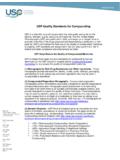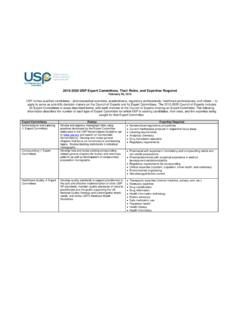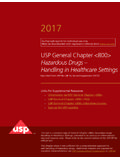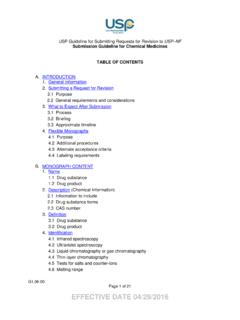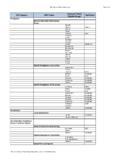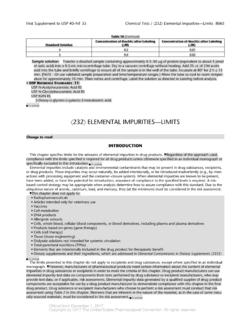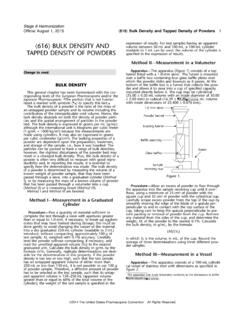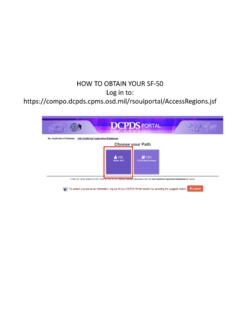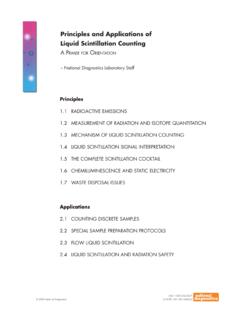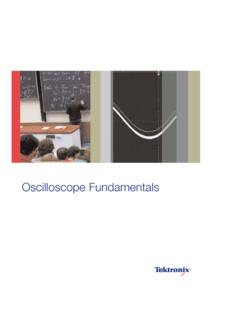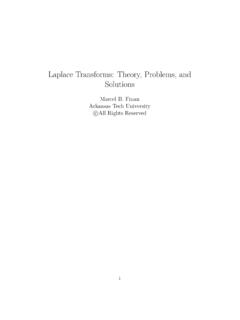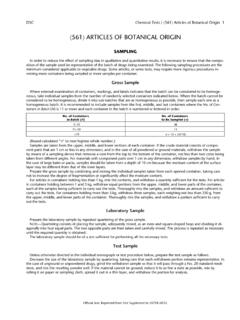Transcription of 232 ELEMENTAL IMPURITIES—LIMITS
1 232 ELEMENTAL IMPURITIES LIMITSINTRODUCTIONThis general chapter specifies limits for the amounts of ELEMENTAL impurities in drug products. ELEMENTAL impurities includecatalysts and environmental contaminants that may be present in drug substances, excipients, or drug products. These impuri-ties may occur naturally, be added intentionally, or be introduced inadvertently ( , by interactions with processing equip-ment and the container closure system). When ELEMENTAL impurities are known to be present, have been added, or have thepotential for introduction, assurance of compliance to the specified levels is required.
2 A risk-based control strategy may be ap-propriate when analysts determine how to assure compliance with this standard. Due to the ubiquitous nature of arsenic, cad-mium, lead, and mercury, they (at the minimum) must be considered in the risk assessment. Regardless of the approach used,compliance with the limits specified is required for all drug products unless otherwise specified in an individual monograph orexcluded in paragraph three of this drug products containing purified proteins and polypeptides (including proteins and polypeptides produced from re-combinant or non-recombinant origins), their derivatives, and products of which they are components ( , conjugates)
3 Arewithin the scope of this chapter, as are drug products containing synthetically produced polypeptides, polynucleotides, chapter does not apply to radiopharmaceuticals, vaccines, cell metabolites, DNA products, allergenic extracts, cells,whole blood, cellular blood components or blood derivatives including plasma and plasma derivatives, dialysate solutions notintended for systemic circulation, and elements that are intentionally included in the drug product for therapeutic benefit. Thischapter does not apply to products based on genes (gene therapy), cells (cell therapy), and tissue (tissue engineering).
4 The limits presented in this chapter do not apply to excipients and drug substances, except where specified in this chapteror in the individual monograph. However, ELEMENTAL impurity levels present in drug substances and excipients must be known,documented, and made available upon chapter does not apply to articles intended only for veterinary use. Requirements listed in this chapter also do not applyto total parenteral nutritions (TPNs) and dialysates. Dietary supplements and their ingredients are addressed in ELEMENTAL Con-taminants in Dietary Supplements 2232 .SPECIATIONThe determination of the oxidation state, organic complex, or combination is termed speciation.
5 Each of the ELEMENTAL im-purities has the potential to be present in differing oxidation or complexation states. However, arsenic and mercury are of par-ticular concern because of the differing toxicities of their inorganic and complexed organic arsenic limits are based on the inorganic (most toxic) form. Arsenic can be measured using a total-arsenic procedureunder the assumption that all arsenic contained in the material under test is in the inorganic form. Where the limit is exceededusing a total-arsenic procedure, it may be possible to show via a procedure that quantifies the different forms that the inorgan-ic form meets the mercury limits are based upon the inorganic (2+) oxidation state.
6 The methyl mercury form (most toxic) is rarely an issuefor pharmaceuticals. Thus, the limit was established assuming the most common (mercuric) inorganic form. Limits for articlesthat have the potential to contain methyl mercury ( , materials derived from fish) are to be provided in the OF EXPOSUREThe toxicity of an ELEMENTAL impurity is related to its extent of exposure (bioavailability). The extent of exposure has beendetermined for each of the ELEMENTAL impurities of interest for three routes of administration: oral, parenteral, and limits are based on chronic exposure.
7 Consider the oral permissible daily exposures (PDEs) in Table 1, as a starting pointin developing specific PDEs for other routes of administration except where otherwise stated in the individual monograph.[NOTE The routes of administration of drug products are defined in Pharmaceutical Dosage Forms 1151 .]DRUG PRODUCTSThe limits described in the second through fourth columns of Table 1 are the base daily dose PDEs of the ELEMENTAL impuri-ties of interest for a drug product taken by a patient according to indicated routes of ProductsParenteral drug products with maximum daily volumes up to 2 L may use the maximum daily volume to calculate permissi-ble concentrations from PDEs.
8 For products whose daily volumes, as specified by labeling and/or established by clinical prac-USP 39 Chemical Tests / 232 ELEMENTAL Impurities Limits 1tice, may exceed 2 L ( , saline, dextrose, TPNs, solutions for irrigation), a 2-L volume may be used to calculate permissibleconcentrations from 1. ELEMENTAL Impurities for Drug ProductsElementOral DailyDose PDEa(mg/day)Parenteral DailyDose PDE(mg/day)Inhalational DailyDose PDE(mg/day)Cadmium522 Lead555 Inorganic arsenica15152 Inorganic mercurya3031 Iridium100101 Osmium100101 Palladium100101 Platinum100101 Rhodium100101 Ruthenium100101 Chromium1100011003 Molybdenum3000150010 Nickel200205 Vanadium100101 Copper300030030a See Speciation for Demonstrating ComplianceDRUG PRODUCT ANALYSIS OPTIONThe results obtained from the analysis of a typical dosage unit, scaled to a maximum daily dose, are compared to the DailyDose Dose PDE measured value (mg/g) maximum daily dose (g/day)
9 The measured amount of each impurity is NMT the Daily Dose PDE, unless otherwise stated in the individual OPTIONS eparately add the amounts of each ELEMENTAL impurity (in mg/g) present in each of the components of the drug product:Daily Dose PDE [SM1(CM WM)] DDM = each ingredient used to manufacture a dosage unitCM = element concentration in component (drug substance or excipient) (mg/g)WM = weight of component in a dosage unit (g/dosage unit)DD = number of units in the maximum daily dose (unit/day)The result of the summation of each impurity is NMT the Daily Dose PDE, unless otherwise stated in the individual mono-graph.
10 Before products can be evaluated using this option, the manufacturer must ensure that additional ELEMENTAL impuritiescannot be inadvertently added through the manufacturing process or via the container closure system over the shelf life of COMPONENT OPTIONFor drug products with a daily dose of NMT 10 g, if all drug substances and excipients in a formulation meet the concentra-tion limits shown in Table 2, then these components may be used in any proportion. No further calculation is necessary. Whileelemental impurities derived from the manufacturing process or the container closure system are not specifically provided forin the Individual Component Option, it is expected that the drug product manufacturer will ensure that these sources do notcontribute significantly to the total content of ELEMENTAL 232 ELEMENTAL Impurities Limits / Chemical TestsUSP 39 Change to read:DRUG SUBSTANCE AND EXCIPIENTSThe concentration of ELEMENTAL impurities in drug substances and excipients must be controlled and, where present, docu-mented.
